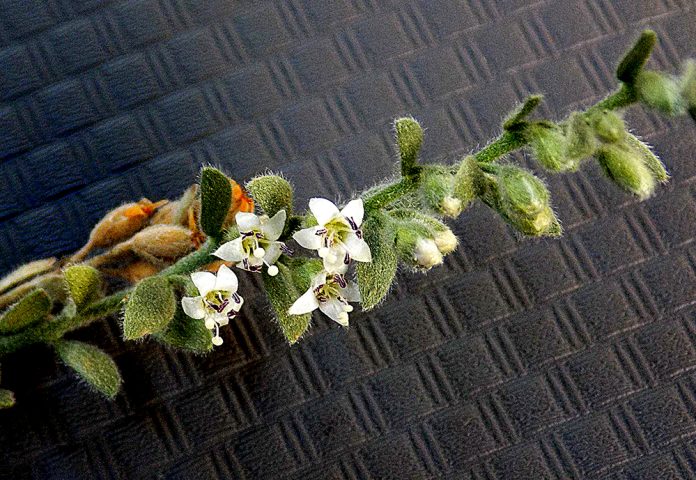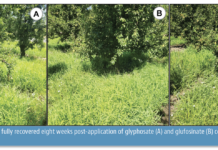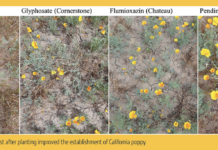Alkaliweed (Cressa truxillensis) is a perennial herb (Figure 1a) native to California. Generally, it is found growing in natural areas, field margins and ditch banks. However, in recent years, it has been observed in agricultural areas. Alkaliweed was first reported as a problematic weed to the UCCE Fresno County in 2016. It is now being widely observed in tree nut orchards, agronomic crops, fallow fields, ditch banks and roadsides. It is more noticeable in young pistachio orchards in the southern Central Valley (Figure 1b). Standard orchard floor management practices such as between-row cultivation and herbicide applications have failed to control this species, and very little information is available on the biology, ecology and management of this species.
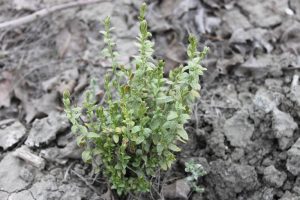
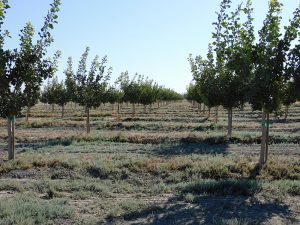
Common herbicides registered for use in orchards, such as glyphosate, glufosinate, salflufenacil, paraquat, 2-4 D, halosulfuron, carfentrazone, rimsulfuron and oxyfluorfen, only seem to suppress the plants for approximately 30 days before the plant starts regrowing. Treatments in pistachio orchards in Kings County showed the herbicide-treated plants regrew from new stems emerging from extensive underground root and/or shoot systems and from the aboveground parts of the treated plant. Similar observations were made in plants that had been cultivated with mechanical equipment. Such observations led us to suspect alkaliweed persists because of its dense aboveground and belowground plant parts (Figure 2a) and rhizome-like structures (Figure 2b).
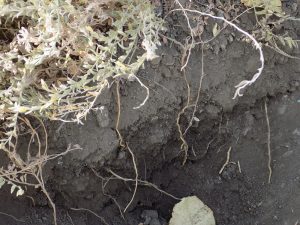
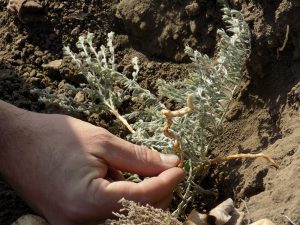
While flowers (Figure 3) and seed are produced, very little is known about their contribution to invasion and spread. Also, very little is known about the germination ecology of its seeds, specifically in response to environmental stresses caused by soil pH, salinity and moisture that occur in the Central Valley. The populations in Kings County were observed in moderately alkaline and saline soils prone to summer drought.
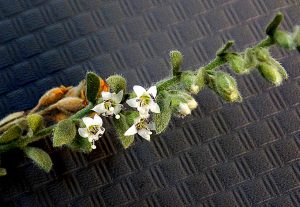
Alkaliweed is stated to be a shade-intolerant plant (USDA-NRCS 2023). Our observations from 2016-18 showed it seemed to prefer and grow better in full sunlight than in shaded conditions. Plants were seen growing throughout young orchard floors that had very little canopy shading, but in older orchards they were observed mainly in the row middles and along unshaded areas of adjacent roadsides and canal banks. Therefore, we believed it was important to assess the shade tolerance ability of alkaliweed because such information could be beneficial in mitigating population spread and in the development of management strategies for this species. If flower and seed production are influenced by shaded conditions in this species, then more options become available in developing management practices to limit its sexual reproduction that contribute to seedbanks.
Although propagation of alkaliweed is primarily stated to be by seed (USDA-NRCS 2023), field observations have shown sprouting ability by underground plant parts that resemble rhizomes or stems as shown in Figure 2, see page 20. However, it is not known for certain what the reproductive potential of these structures are in alkaliweed and this needs to be studied, because limiting both seedbanks and bud banks may be necessary to effectively manage this species.
Therefore, we undertook a study on alkaliweed to 1) assess the germination of its seeds in response to environmental stresses such as pH, salinity, and moisture; 2) assess the impact of different levels of shade (full sunlight, 70% of full sunlight and 30% of full sunlight) on its aboveground growth and morphology; and 3) assess the effect of postemergence herbicides on its suppression.
Seed Germination
Seed germination experiments were conducted in a controlled-environment growth chamber at California State University, Fresno. Seed germination was tested under a range of pH solutions (5, 6, 7, 8 and 9) prepared using sodium hydroxide (NaOH) and hydrochloric acid (HCl) proportions. Germination was also tested in a range of salinity solutions measured by electrical conductivity (EC) of 0, 2.5, 5, 10, 15 and 20 dS/m (1 dS/m = 1 mmho/cm) that were prepared using laboratory-grade sodium chloride (NaCl). Furthermore, germination was tested under a range of water potential (ψ) solutions (0, -0.51, -1.88, -2.89, -4.12 and -5.56 MPa) prepared using polyethylene glycol (PEG 6000) to assess the drought tolerance of seeds for germination.
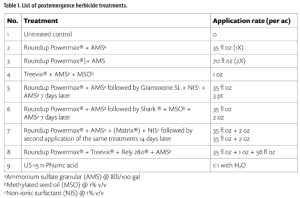
Effect of Shade on Alkaliweed Growth and Reproduction
An alkaliweed-infested roadside alongside the top of a ditch bank in Stratford, Calif. adjacent to a seven-year-old pistachio orchard infested with alkaliweed was used to study the effects of full sun and shade on alkaliweed morphology and growth. Shade tents (Figure 4) were constructed with PVC pipe frames and fitted with shade clothes representing 30% shade (70% of full sun) and 70% shade (30% of full sun). The shade tents were set up before alkaliweed plants emerged from the soil. Each treatment was replicated four times in a randomized complete block design. The photosynthetically active radiation (PAR) inside and outside the tents was taken every week between 11:00 a.m. and 1:00 p.m. using a hand-held quantum sensor. The number of plants and number of plants with flowers in the treatments were counted at the onset of flowering. The plants were harvested once five plants within a random area in each treatment plot had flowered. The plants were clipped at the soil surface, put into paper bags, and transported to the lab at Fresno State. In the lab, fresh weight of the five plants per treatment were taken, and the number of flowers and internodes on each plant were counted. The internode length on each plant was measured and recorded. The total leaf area on each plant was measured using a leaf area meter. The parts of the five plants were put together in separate paper bags for each treatment and placed in a forced-air oven and the dry weights were recorded after three days. The experiment was conducted from April to August 2019.
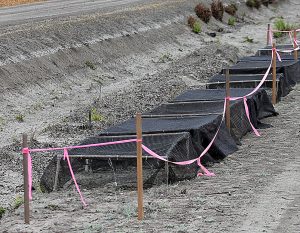
Postemergence Herbicides on Alkaliweed
The effect of postemergence herbicides on alkaliweed was tested by spraying actively growing plants on the edge of the road outside a pistachio orchard in Stratford on April 11, 2018. Since the plants had more of a semi-prostrate growth habit, the plants were approximately 1 to 1.5 inches tall and 6 inches in diameter at the time of the spray. The herbicide treatments included one-time applications, sequential applications and tank mixtures of herbicides (Table 1). Adjuvants were added to the herbicide treatments as recommended by each herbicide label and the solutions in all the treatments were buffered to a pH of 5.5 using BioLink® acidifier (Westbridge Agricultural Products, Vista, Calif). The herbicides were applied with a two-nozzle (Turbotwinjet 11004, Model TTJ60) spray boom using a CO2 backpack sprayer calibrated to spray 34.6 gallons/acre at 3 miles/hour. The spray pressure and spray height were maintained at 30 psi and 18 inches above the plant, respectively. Each treatment plot was 30 feet long and 3.3 feet wide. The experimental design was a randomized complete block with four replications of each treatment. The alkaliweed plants were evaluated at weekly intervals up to 28 days after treatment (DAT) for mortality on a scale of 0 to 100 where 0 was considered completely healthy without necrotic symptoms and 100 was considered entirely dead with no green tissue remaining.
Data for each of the experiments above were analyzed using analysis of variance (ANOVA) and when the analysis showed a significance at α=0.05, the means were separated using Fisher’s Least Significant Difference tests. Regression analysis was also used for the germination studies.
Effect of Environmental Factors on Seed Germination
Alkaliweed seeds were moderately drought-tolerant as germination was 68.5% at -0.51 MPa and 12% of the seeds germinated at a fairly high negative water potential of -1.09 MPa. There was no germination beyond water potential values of -1.09 MPa. The water potential level that reduced seed germination by 50% was estimated as -0.78 MPa. For comparison, in field bindweed (Convolvulus arvensis), another plant of the Convolvulaceae family, the water potential that reduced germination by 50% was estimated as -0.4 MPa (Tanveer et al. 2013). Therefore, it appears alkaliweed seeds are more tolerant to water potential stress than field bindweed during germination, enabling it to germinate in the semiarid regions of the Central Valley under fairly dry conditions.
Alkaliweed seeds were very tolerant to salinity (sodium chloride) stress at germination as approximately 24% of the seeds germinated at a very high EC level of 20 dS/m, although percent germination was significantly lowered at EC levels higher than 10 dS/m. The salinity level that reduced seed germination by 50% was estimated as 15.3 dS/m. Again, there are no studies that have reported the effect of salinity levels on alkaliweed, but in field bindweed Tanveer et al. (2013) reported similar tolerance to salinity stress. Therefore, alkaliweed can germinate in the high-salinity regions of the westside of the Central Valley.
Unlike water potential and salinity, germination of alkaliweed seeds was not affected by the range of the pH levels tested. Germination was similar at all pH levels (5 to 9) and ranged from 76% to 84%, indicating this species has a wide range of adaptation to pH levels during germination. Although more than 80% of the seeds germinated at a pH level of 5, it is not known if the plants would grow and reproduce at this pH level because the optimum pH range for growth of this species is reported as 6.8 to 9.2 (USDA-NRCS 2023). Again, there are no published studies on the germination of alkaliweed seed in response to pH, but Tanveer et al. (2013) reported that field bindweed germinated at a pH range of 4 to 9 but the optimum pH was 6 to 8. Therefore, it appears that alkaliweed can germinate in the alkaline and acidic soils of the Central Valley.
Effect of Shade on Growth of Alkaliweed
Shade levels influenced the morphology, growth and reproductive potential of alkaliweed plants. The PAR taken close to noon in the treatment plots during the experiment, on average, ranged from 1700 to 2000, 1000 to 1300 and 500 to 700 µmol m-2 s-1 in the full sun, 30% shade and 70% shade, respectively. Although the total aboveground biomass and number of internodes on the stem were not affected by shade level, other morphological characters showed that this species was not a shade-tolerant plant and that plants exhibited efforts to adapt to shade. For example, the length of internodes on the stem increased as the level of shade increased. The average length of the internodes in the plants growing in the full sun was approximately 1.3 inches whereas at 70% shade it was approximately 3.5 inches. Similarly, the total leaf area per plant was higher in the plants grown in the shade than in the full sun. Leaf thickness was not measured in the study. However, it is suspected that leaves on the plants growing in the shade were comparatively thinner than on those growing in the full sun because thin leaves are an adaptation strategy of shade-intolerant plants when growing under shade (Glime 2017). Similar results were reported in field bindweed where internode length and total leaf area were lesser in plants grown in the full sun than those grown under shade (Gianoli 2001). However, field bindweed is more of a viny plant than alkaliweed.
Although the plants growing in the shade had similar aboveground biomass as those in the full sun, none of the plants in either the 30% or the 70% shade treatments produced any flowers for the duration of this study. Therefore, it appears that reproduction can be severely inhibited in alkaliweed by shade, and use of shading strategies may be an effective management method to reduce sexual reproduction of this species.
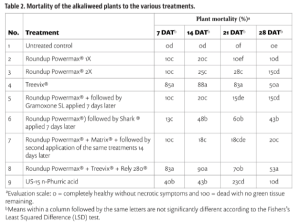
Effect of Postemergence Herbicides on Alkaliweed
Plant mortality differed between the herbicide treatments at each evaluation date (Table 2). Initially, saflufenacil (alone) and the tank mix of glyphosate + saflufenacil + glufosinate looked promising as more than 80% of the plants showed injury symptoms at 7 DAT and the plants appeared to be dying. However, by 28 DAT, the plants regrew, and the mortality was reduced to 50% and 53%, respectively, for the two treatments. This level of control would not be considered acceptable to a grower managing alkaliweed. None of the herbicide treatments provided acceptable control as the mortality rate was 20% or less in most cases. It was expected that the sequential application treatments would work better but it was not the case. Sequential applications of glyphosate and carfentrazone provided 43% control whereas that of glyphosate and paraquat provided only 15% control. Although appropriate adjuvants were applied in all the treatments, the postemergence herbicides failed to control the plants which is perhaps due to reduced contact, retention and absorption of the herbicides because of the hairiness of the alkaliweed plants as observed under a microscope (Figure 5). Even the leaves of small plants were observed to be hairy. Also, it is not known if the regrowth is because of adequate levels of stored carbohydrates or growth of new stems (aboveground or belowground) as discussed earlier. Therefore, alkaliweed control may not be feasible using postemergence herbicides alone. It has been reported that 2,4-D can provide some level of control but in-season use of this herbicide in orchards could be a concern due to phytotoxic effects on the trees.
Our study showed alkaliweed seeds could germinate in moderate drought and high salinity conditions under a range of soil pH. The species was not very shade-tolerant, and no reproductive structures were observed in the plants growing in the 30 and 70% shade levels. None of the postemergence herbicides provided adequate control of the plants. Therefore, an integrated management plan which includes multiple tactics needs to be developed for managing alkaliweed in Central Valley orchards. Complete details on this study are available at mdpi.com/2392752.
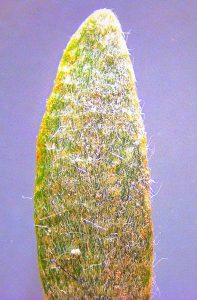
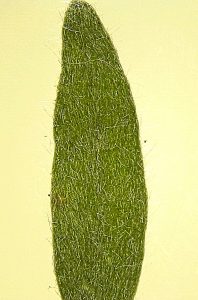
We would like to thank Mr. Kevin Brooks, PCA, for the wealth of information provided on alkaliweed.
References
Gianoli E. 2001. Lack of differential plasticity to shading of internodes and petioles with growth habit in Convolvulus arvensis (Convolvulaceae). Int J Plant Sci 162:1247–1252. https://doi.org/10.1086/322950.
Glime J. 2017. Light: Adaptations for Shade. In: Glime, J. M. Bryophyte Ecology. Volume 1. Physiological Ecology. 9-2-1, http://digitalcommons.mtu.edu/bryophyte-ecology.
Tanveer A, Tasneem M, Khaliq A, et al. 2013. Influence of seed size and ecological factors on the germination and emergence of field bindweed (Convolvulus arvensis). Plant daninha 31(1) https://doi.org/10.1590/S0100-83582013000100005.
USDA-NRCS, 2023. Conservation plant characteristics, Cressa truxillensis Kunth, spreading alkaliweed, CRTR5. https://plantsorig.sc.egov.usda.gov/java/charProfile?symbol=CRTR5.











